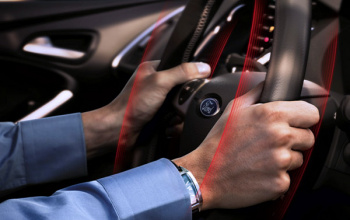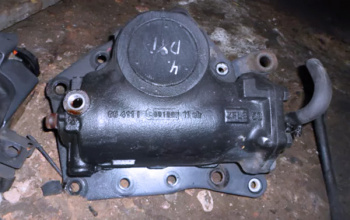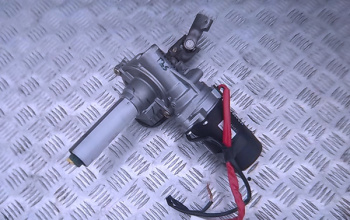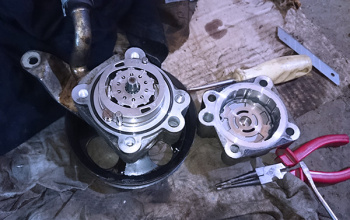
Do you suspect that your power steering system is broken? It is usually fairly easy to recognize, because your steering wheel is much heavier than normal. However, there are other signs that your power steering is defective. You can read here which signs these are.
First, however, we tell something about power steering system itself. What is it exactly? How does it work? We also discuss the most common problems with the steering assistance system and we tell you what it costs to have it repaired.
What is power steering system?
Power steering system is a steering assistance system that makes the life of today’s driver a lot easier. This is because a lot of force is needed to turn the wheels over the asphalt, especially when you drive slowly, such as when parking. The ingeniously designed power steering system helps you with this: with a pump or an electric motor, the turn that you give to your steering is enhanced. This means it takes a lot less effort to steer: you have to put less power and you have to run less.
How does power steering work?
There are two types of power steering:
- A hydraulic system
- A system with an electric motor
In principle, these two work the same: they reinforce the movement that you make when you turn the steering wheel. In practice, however, there are major differences in how they do this.
Hydraulic power steering system – Operation

A hydraulic power steering system consists of four important components:
- A power steering pump
- Cylinders filled with oil
- Snakes
- The V-belt (also called multi belt)
The cylinders are connected to the wheelhouse. With the aid of the pump, the oil pressure is regulated via the hoses in the cylinders. When you steer, the pressure increases and the oil pushes your handlebars in the right direction. If you go straight again, the pressure will be reduced again.
The pump can do its job because it is connected to the motor via the V-belt (to which, for example, the alternator and air conditioning pump are connected). That is a great system, but the disadvantage is that the pump always runs, even when you are not steering. This costs extra fuel. The pump is also relatively heavy and takes up quite some space. That is why many new cars nowadays use electric power steering.
Electric power steering – Operation

Electric power steering (EPS) system works with three main components:
- An electric motor
- A control unit (computer)
- Sensors
The electric motor is connected to the wheelhouse, which in turn draws its power from the battery. When you turn the wheel, the sensors will register this and send a signal to the control unit. This then sends a signal to the electric motor, which will turn and provide support with your steering movement. You can compare this with the operation of an electric bicycle: the motor will only run if you pedal yourself.
This system is a lot lighter and more economical, because it is only activated when you steer. In addition, the degree of excitation can be easily controlled with the control unit. For example, many modern cars will adapt the power that the engine gives to the situation: this will work hard if you drive slowly, and hardly give any power on the highway.
Power steering system broken – Symptoms
A defective power steering system is accompanied by some very obvious and slightly less obvious signs. You probably expected Symptoms 1 and 2, but many people think that Symptoms 3,4 and 5 have nothing to do with them. If your car is equipped with an electric power steering, you will not encounter symptoms 3,4 and 5.
1. Power steering system does not work – Heavy steering
Most people notice that their power steering has broken when it simply no longer works. The steering wheel suddenly turns very difficult and heavy, making it immediately clear that something is wrong with this system.
2. A light on your dashboard is ON.
A defect in the power steering unit will often be accompanied by a light on your dashboard. Many cars have a separate light for power steering. Otherwise the engine failure light will come on.
3. Sounds when steering
Sounds are never good. That is the case with people, and no less with cars. When you bend your knee and you hear a sound, it is time to visit the repair mechanic. When you steer and you hear a squeaky sound, it is also time to check whether your wheelhouse is still good. In many cases, this noise is in fact a sign of a leak in the hydraulic system. There is not enough oil in the pistons, so you can hear them move. Sounds when steering can also indicate a slipping multi belt. See also symptom 5 for this.
4. Delay in steering
These noises will often be accompanied by a slower operating steering assist system. When the oil pressure in the system becomes lower, it may react less quickly to your movements. As a result, you will notice a delay between turning the steering wheel and the actual turning of the wheels.
5. Noises when starting the car
Peeping noises when starting the car usually indicate a problem with the multi-belt (V-belt). The sound means that the belt has become somewhat stretched, and has become looser. This means it cannot work optimally. Because a hydraulic power steering for its drive depends on the proper functioning of the multi-belt, the air conditioning pump will also not work optimally. So when you hear a beeping sound when starting and steering, the power steering system will also cause problems.
Can you continue driving with a broken power steering system?
Some people think that because a car used to have no power steering, you can now drive without it. In theory this is true, but only if there was never one built in. The system is connected to the wheelhouse, so there is a chance that the car will not be able to steer at all if the power steering is defective. This can be very dangerous and you should definitely not keep driving it!
Car with defective power steering
Moreover, the wheelhouse is one of the most important points at which a car is inspected. This must work well. If the power steering does not work or shows problems, your car will be rejected. Only after repair can you get back on the road with it.
Causes of broken power steering system
There are various reasons for a malfunctioning power steering unit. These depend on the type of power steering that you have installed in your car. We list the most common defects below.
Problems with hydraulic steering assistance systems
- Worn pump. The most common defect is a broken power steering pump. This is always on when your engine is running, so it will show wear over the years. In the long run, it loses its effect, making the system less effective.
- Leaks. Sufficient oil pressure is important for the system to function properly. Leaks in the pipes or connection points can cause oil to leak out, reducing the pressure and eventually reducing its effect.
- Contaminated power steering oil. The oil in the system must be regularly checked and replaced. If this does not happen, the system can become contaminated, resulting in blockages, broken pumps and leaks. Good maintenance is therefore very important.
- Worn out V-belt. The power steering pump is driven by the V-belt. If it is worn out, it will slip and the pump will not get enough energy. As a result, it cannot work properly.
Problems with electric steering assist systems
- Sensor fault. In many cases, a problem with the sensor will be the cause of a non-functioning EPS. Because the sensor no longer registers that the steering wheel is turning, you can turn it as hard as you want: the electric motor will do nothing.
- Fault in the control unit. Very occasionally the malfunction is in the computer that controls the level of support.
- A blown fuse. Just like a building, a car is equipped with fuses to protect the electrical components against short circuits. When a fuse blows, the EPS may fail. Replacing the fuse will in many cases not help, because it does not address the cause of the short circuit.
- Electric motor is not working properly. The electric motor provides the power needed to give you the right support. It cannot work properly due to various reasons. It may be worn out itself, or there may be a problem with the battery, the alternator or the wiring that prevents it from getting enough electricity.
Power steering defective – Repair costs

The costs for having the power steering system repaired depend on the type (hydraulic or electrical) and of course what exactly is going on. In particular with hydraulic systems, several parts will be replaced at the same time and, of course, new oil must be added.
Furthermore, the costs depend on the type of car you have and where you have the repair carried out. In general, repairs will cost more at a brand dealer than at a general garage, because the wage here is higher. See the table below for an overview of the expected repair costs.
| Defect | Cost of device | Costs of labor | Total |
|---|---|---|---|
| Hydraulic system | |||
| Change oil | € 20-30 | € 10-20 | € 30 – 50 |
| Pump | € 150 – 300 | € 100 – 200 | € 250 – 500 |
| Piping | € 10 – 70 | € 60 – 120 | € 70 – 210 |
| Multi belt | € 30 – 60 | € 30 – 60 | € 60 – 120 |
| Complete wheelhouse | € 600 – 1200 | € 150 – 300 | € 750 – 1500 |
| Electric system (EPS) | |||
| Sensor | € 70 – 200 | € 100 – 300 | € 170-500 |
| Control unit | € 600 – 3000 | € 100 – 300 | € 700 – 3300 |
| Electric motor | € 1000 – 2000 | € 200 – 400 | € 1200 – 2400 |
| Fuse | € 1 – 5 | € 10-20 | € 11 – 25 |